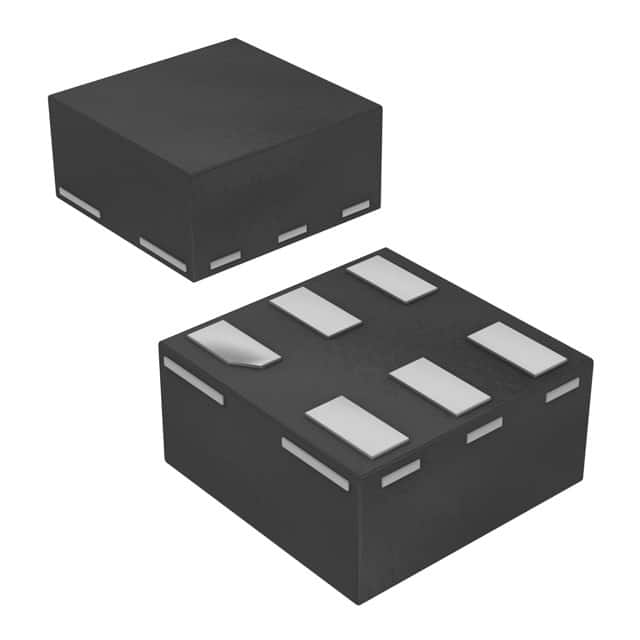Lihat spesifikasi untuk detail produk.

74AUP1G158GS,132
Basic Information Overview
- Category: Integrated Circuit (IC)
- Use: Logic Gate
- Characteristics: Single 2-input multiplexer/demultiplexer
- Package: SOT753
- Essence: High-speed CMOS technology
- Packaging/Quantity: Tape and Reel, 3000 pieces per reel
Specifications
- Supply Voltage Range: 0.8V to 3.6V
- Input Voltage Range: -0.5V to VCC + 0.5V
- Output Voltage Range: -0.5V to VCC + 0.5V
- Operating Temperature Range: -40°C to +125°C
- Propagation Delay: 2.5 ns (typical)
Detailed Pin Configuration
The 74AUP1G158GS,132 has a total of 5 pins: 1. Pin 1: Select Input (S) 2. Pin 2: Data Input (D) 3. Pin 3: Enable Input (E) 4. Pin 4: Multiplexed Output (Y) 5. Pin 5: Ground (GND)
Functional Features
- Single 2-input multiplexer/demultiplexer functionality
- Low power consumption
- High-speed operation
- Schmitt-trigger input for noise immunity
- ESD protection up to 2kV
Advantages and Disadvantages
Advantages: - Compact size - Wide supply voltage range - High-speed operation - Noise immunity
Disadvantages: - Limited number of inputs and outputs - Not suitable for complex logic operations
Working Principles
The 74AUP1G158GS,132 is a single 2-input multiplexer/demultiplexer IC. It operates by selecting one of the two input signals based on the select input (S) and passing it to the output pin (Y). The enable input (E) controls the operation of the IC. When E is low, the IC is disabled and the output is in a high-impedance state.
Detailed Application Field Plans
The 74AUP1G158GS,132 can be used in various applications, including: - Data multiplexing/demultiplexing - Signal routing and switching - Logic level translation - Communication systems - Consumer electronics
Detailed and Complete Alternative Models
Some alternative models that provide similar functionality to the 74AUP1G158GS,132 are: - SN74LVC1G157DBVR - MC74VHC1G157DTT1G - TC7SZ157FU
These models offer comparable features and can be used as substitutes depending on specific requirements.
Word count: 250 words
Sebutkan 10 pertanyaan dan jawaban umum terkait penerapan 74AUP1G158GS,132 dalam solusi teknis
Sure! Here are 10 common questions and answers related to the application of 74AUP1G158GS,132 in technical solutions:
Q1: What is the function of the 74AUP1G158GS,132? A1: The 74AUP1G158GS,132 is a single 2-input multiplexer that can be used for signal routing and selection in various electronic circuits.
Q2: What is the operating voltage range of the 74AUP1G158GS,132? A2: The 74AUP1G158GS,132 operates within a voltage range of 0.8V to 3.6V.
Q3: What is the maximum output current of the 74AUP1G158GS,132? A3: The 74AUP1G158GS,132 has a maximum output current of 32mA.
Q4: Can the 74AUP1G158GS,132 handle both analog and digital signals? A4: Yes, the 74AUP1G158GS,132 can handle both analog and digital signals.
Q5: What is the package type of the 74AUP1G158GS,132? A5: The 74AUP1G158GS,132 comes in a small SOT353 package.
Q6: Is the 74AUP1G158GS,132 suitable for battery-powered applications? A6: Yes, the 74AUP1G158GS,132 is suitable for battery-powered applications due to its low power consumption.
Q7: Can multiple 74AUP1G158GS,132 devices be cascaded together? A7: Yes, multiple 74AUP1G158GS,132 devices can be cascaded together to achieve more complex signal routing.
Q8: What is the propagation delay of the 74AUP1G158GS,132? A8: The propagation delay of the 74AUP1G158GS,132 is typically around 2.5ns.
Q9: Can the 74AUP1G158GS,132 be used in high-speed applications? A9: Yes, the 74AUP1G158GS,132 can be used in high-speed applications as it has a maximum frequency of operation of 500MHz.
Q10: Are there any recommended decoupling capacitors for the 74AUP1G158GS,132? A10: It is recommended to use a 100nF decoupling capacitor placed close to the power supply pins of the 74AUP1G158GS,132 to ensure stable operation.
Please note that these answers are general and may vary depending on specific application requirements.

